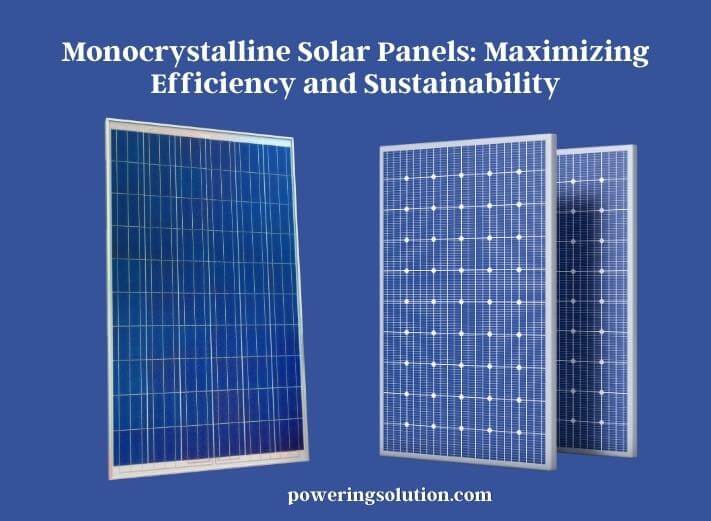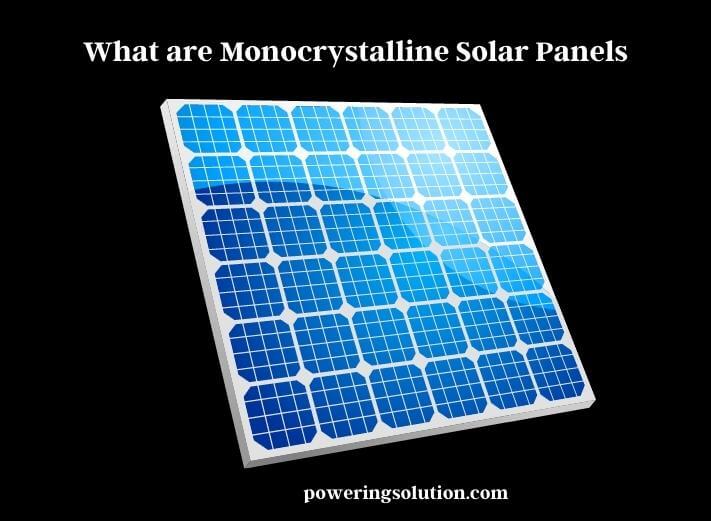Solar energy is becoming an increasingly important source of renewable energy as society seeks to reduce its dependence on non-renewable energy sources. Among the various types of solar panels available in the market, monocrystalline solar panels are considered to be one of the most efficient and sustainable.

Monocrystalline solar panels are made up of high-purity silicon crystals and have a single, uniform structure. This unique structure makes monocrystalline solar panels more efficient at converting sunlight into electricity, resulting in higher power output per square meter compared to other types of solar panels.
In addition to their high efficiency, monocrystalline solar panels have a longer lifespan compared to other types of solar panels and are less susceptible to performance degradation over time. This means that monocrystalline solar panels can provide a reliable and consistent source of electricity over the course of their lifespan.
As the world becomes increasingly aware of the need to transition towards sustainable sources of energy, the demand for high-efficiency and sustainable solar panels like monocrystalline solar panels is expected to increase.
What are Monocrystalline Solar Panels?
Monocrystalline solar panels are a type of solar panel that is made from high-purity silicon crystals. These crystals are carefully grown into a single, uniform structure, resulting in a panel with a unique, smooth appearance. This single-crystal structure makes monocrystalline solar panels more efficient at converting sunlight into electricity compared to other types of solar panels.
The production process for monocrystalline solar panels involves cutting thin wafers from a single crystal of high-purity silicon. These wafers are then assembled into a panel, with each wafer functioning as a separate solar cell. The cells are wired together to form a circuit, which then produces electricity when exposed to sunlight.

The unique structure of monocrystalline solar panels also makes them more durable and longer-lasting compared to other types of solar panels. They are less susceptible to damage from temperature fluctuations, moisture, and other environmental factors, and are less likely to degrade over time.
Advantages of Monocrystalline Solar Panels
There are several advantages to using monocrystalline solar panels for solar energy systems. Here are some of the main advantages:
- High efficiency: Monocrystalline solar panels are known for their high efficiency at converting sunlight into electricity. Their single-crystal structure makes them more efficient than other types of solar panels, resulting in higher power output per square meter.
- Small footprint: Monocrystalline solar panels are also more compact compared to other types of solar panels, meaning they require less space to generate the same amount of electricity. This makes them a good option for smaller homes or businesses with limited roof space.
- Durability: Monocrystalline solar panels have a longer lifespan compared to other types of solar panels, and are less susceptible to damage from environmental factors such as moisture or temperature fluctuations. This means they can provide a reliable source of electricity over the course of their lifespan.
- Sustainability: Monocrystalline solar panels are a sustainable source of energy as they do not produce greenhouse gas emissions during their operation. The production process for monocrystalline solar panels is becoming more environmentally friendly as manufacturers seek to reduce their carbon footprint.
- Aesthetics: The uniform structure of monocrystalline solar panels gives them a sleek and modern appearance, making them a popular choice for homeowners who want to install solar panels without compromising the appearance of their homes.
The high efficiency, small footprint, durability, sustainability, and aesthetic appeal of monocrystalline solar panels make them an attractive option for those seeking to transition to renewable energy sources.
Maximizing Efficiency of Monocrystalline Solar Panels
Maximizing the efficiency of monocrystalline solar panels is a top priority for solar energy system owners, as it directly impacts the amount of electricity generated and the overall return on investment. Here are some ways to maximize the efficiency of monocrystalline solar panels:
The angle and direction of the solar panels play a significant role in the amount of sunlight they receive. It is recommended that monocrystalline solar panels be installed facing south in the northern hemisphere or north in the southern hemisphere and tilted at an angle equal to the latitude of the installation site.
Dust, debris, and other particles can accumulate on the surface of solar panels, reducing their efficiency. It is important to regularly clean the panels using a soft cloth and water to remove any dirt or debris. Additionally, routine maintenance, such as checking the wiring and connections, can ensure that the solar panels are functioning optimally.
The efficiency of monocrystalline solar panels can also be affected by the quality of the equipment used in the solar energy system. Investing in high-quality inverters, charge controllers, and other equipment can help to maximize the efficiency of the entire system.
Oversizing or under-sizing the solar energy system can also impact the efficiency of monocrystalline solar panels. It is important to properly size the system based on the energy needs of the home or business to ensure that the panels are generating the appropriate amount of electricity.
Keeping track of the amount of electricity generated by the solar panels can help to identify any potential issues that may be impacting their efficiency. Energy monitoring systems can provide real-time data on energy production, allowing owners to adjust their systems as needed.
By implementing these strategies, owners of monocrystalline solar panels can maximize the efficiency of their solar energy system, ultimately reducing energy costs and promoting a more sustainable future.
Sustainability of Monocrystalline Solar Panels
Sustainability is a key factor to consider when evaluating the effectiveness of solar energy systems, including those that utilize monocrystalline solar panels. Here are some ways that monocrystalline solar panels contribute to sustainability:
- Clean energy production: One of the primary benefits of monocrystalline solar panels is that they produce clean, renewable energy without emitting greenhouse gases or other harmful pollutants. This makes them a much more environmentally friendly energy source compared to fossil fuels.
- Long lifespan: Monocrystalline solar panels have a long lifespan, typically lasting for 25 years or more. This means that they can provide a reliable source of clean energy for an extended period of time, reducing the need to rely on non-renewable energy sources.
- Reduced reliance on the grid: By generating their own electricity, those who use monocrystalline solar panels can reduce their reliance on the electrical grid, ultimately reducing the overall demand for fossil fuels.
- Sustainable production methods: The production of monocrystalline solar panels is becoming more environmentally friendly as manufacturers seek to reduce their carbon footprint. Many manufacturers are implementing sustainable production methods, such as using renewable energy sources to power their manufacturing facilities and reducing waste during the production process.
- Recycling options: At the end of their lifespan, monocrystalline solar panels can be recycled, allowing for the recovery of valuable materials such as silicon and silver. Recycling reduces the amount of waste sent to landfills and helps to conserve natural resources.
Comparison With Other Solar Panels
When considering solar panels for your home or business, it’s important to understand the differences between monocrystalline solar panels and other types of solar panels. Here’s a comparison of monocrystalline solar panels with other types of solar panels:
- Polycrystalline solar panels: Polycrystalline solar panels are made from multiple silicon fragments rather than a single crystal, which makes them less efficient than monocrystalline solar panels. While they are typically less expensive than monocrystalline solar panels, they also take up more space on your roof, which may be a concern if you have limited roof space.
- Thin-film solar panels: Thin-film solar panels are made by depositing a thin layer of photovoltaic material onto a substrate, such as glass or metal. While they are the most lightweight and flexible type of solar panel, they are also less efficient than both monocrystalline and polycrystalline solar panels. Additionally, they degrade faster over time and require more maintenance than other types of solar panels.
- Bifacial solar panels: Bifacial solar panels are able to capture light on both sides of the panel, which makes them more efficient than traditional solar panels. They are also more expensive and may not be as widely available as other types of solar panels.
- Concentrated solar panels: Concentrated solar panels use mirrors or lenses to focus sunlight onto a small area of photovoltaic material. While they are the most efficient type of solar panel, they are also the most expensive and complex to install.
While they may be more expensive upfront, they can ultimately provide greater long-term savings and sustainability benefits. It’s important to consider your individual needs and budget when selecting the best solar panel for your specific situation.
Future of Monocrystalline Solar Panels
As solar energy becomes an increasingly popular source of renewable energy, the future of monocrystalline solar panels looks promising. Here are a few ways that monocrystalline solar panels may continue to evolve and improve in the future:
Increased Efficiency:
Monocrystalline solar panels have already made significant strides in improving efficiency in recent years. As technology advances and manufacturing processes become more efficient, it’s possible that monocrystalline solar panels will become even more efficient in the future. This could mean that smaller, more compact panels could produce the same amount of power as larger, less efficient panels.
Improved Sustainability:
As consumers and businesses become more focused on sustainability, there is a growing demand for solar panels that are produced using environmentally-friendly materials and manufacturing processes. Monocrystalline solar panels are already considered to be a sustainable choice due to their long lifespan and low maintenance requirements. In the future, it’s possible that manufacturers may find ways to further reduce the environmental impact of monocrystalline solar panels through innovations in production processes and materials.
Integration With Smart Home Technology:
As smart home technology continues to advance, there may be opportunities to integrate monocrystalline solar panels with other smart home systems. For example, solar panels could be connected to smart thermostats or other energy-efficient appliances, allowing homeowners to optimize their energy usage and reduce their reliance on the grid.
Increased Accessibility:
While monocrystalline solar panels are already becoming more affordable, it’s possible that they will continue to decrease in price as manufacturing processes become more efficient and demand increases. As a result, more homeowners and businesses may be able to afford to invest in solar panels, leading to broader adoption of solar energy.
The future of monocrystalline solar panels looks bright. With continued advancements in efficiency, sustainability, and accessibility, they are likely to play an increasingly important role in the transition to renewable energy.
In a Nutshell
Monocrystalline solar panels offer several advantages over other types of solar panels, including higher efficiency and longer lifespan. They are also a sustainable choice, producing clean energy without emitting greenhouse gases.
As demand for renewable energy continues to grow, monocrystalline solar panels are likely to become increasingly popular due to their many benefits. Moreover, as technology advances and manufacturing processes become more efficient, we can expect to see further improvements in the efficiency and sustainability of monocrystalline solar panels. Ultimately, the future of solar energy looks promising, and monocrystalline solar panels are poised to play a key role in the transition to a cleaner, more sustainable energy system.
